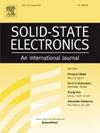基于双极主体的高效有机发光器件性能增强研究
IF 1.4
4区 物理与天体物理
Q3 ENGINEERING, ELECTRICAL & ELECTRONIC
引用次数: 0
摘要
我们开发了一种高效磷光有机发光器件(OLED),利用双极性宿主结合供体和受体部分,特别是三苯胺和苯并咪唑。优化后的器件表现出优异的性能,最大外量子效率达到18.95%,亮度达到122,300 cd/m2。这些结果与基准器件相比有了显著的增强,基准器件的最大EQE为9.43%,亮度为25,450 cd/m2。此外,在采用双极主体材料的器件中,效率滚降显著降低。通过各种研究技术,包括时间分辨光致发光、瞬态电致发光和电容电压测量,我们确定了优化装置效率提高的基本因素是由于发射层内载流子捕获减少而导致的三重极化子湮灭减少。相反,使用单极主体的参考器件表现出明显的载流子捕获,导致严重的三重极化子湮灭,从而导致较低的效率。这些发现证明了减轻三重极化子湮灭在实现优异器件性能中的关键作用。这些结果为先进有机发光器件的设计提供了有价值的见解,并突出了双极主体在实现高性能有机电致发光应用方面的潜力。本文章由计算机程序翻译,如有差异,请以英文原文为准。

Investigation of performance enhancement in high-efficiency organic light-emitting device based on a bipolar host
We have developed a highly efficient phosphorescent organic light-emitting device (OLED) utilizing a bipolar host incorporating both donor and acceptor moieties, specifically triphenylamine and phenanthroimidazole. The optimized device demonstrated exceptional performance, achieving a maximum external quantum efficiency of 18.95 % and a luminance of 122,300 cd/m2. These results represent a significant enhancement compared to the reference device, which exhibited a maximum EQE of 9.43 % and a luminance of 25,450 cd/m2. Additionally, the efficiency roll-off was markedly reduced in the device incorporating the bipolar host material. Through various investigative techniques, including time-resolved photoluminescence, transient electroluminescence, and capacitance–voltage measurements, we identified that the fundamental factor for the enhanced efficiency of the optimized device is the reduction of triplet–polaron annihilation, resulting from decreased carrier trapping within the emitting layer. Conversely, the reference device, utilizing a unipolar host, exhibited significant carrier trapping, leading to severe triplet–polaron annihilation and consequently inferior efficiency. These findings demonstrate the critical role of mitigating triplet–polaron annihilation in achieving superior device performance. The results provide valuable insights into the design of advanced organic light-emitting devices and highlight the potential of bipolar hosts in achieving high-performance organic electroluminescent applications.
求助全文
通过发布文献求助,成功后即可免费获取论文全文。
去求助
来源期刊

Solid-state Electronics
物理-工程:电子与电气
CiteScore
3.00
自引率
5.90%
发文量
212
审稿时长
3 months
期刊介绍:
It is the aim of this journal to bring together in one publication outstanding papers reporting new and original work in the following areas: (1) applications of solid-state physics and technology to electronics and optoelectronics, including theory and device design; (2) optical, electrical, morphological characterization techniques and parameter extraction of devices; (3) fabrication of semiconductor devices, and also device-related materials growth, measurement and evaluation; (4) the physics and modeling of submicron and nanoscale microelectronic and optoelectronic devices, including processing, measurement, and performance evaluation; (5) applications of numerical methods to the modeling and simulation of solid-state devices and processes; and (6) nanoscale electronic and optoelectronic devices, photovoltaics, sensors, and MEMS based on semiconductor and alternative electronic materials; (7) synthesis and electrooptical properties of materials for novel devices.
 求助内容:
求助内容: 应助结果提醒方式:
应助结果提醒方式:


